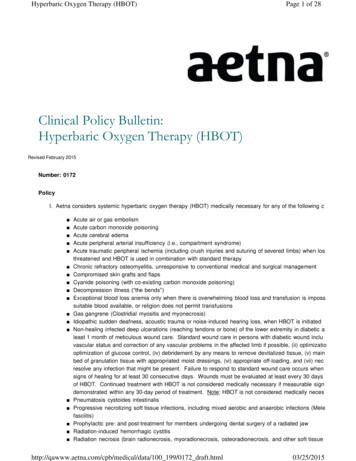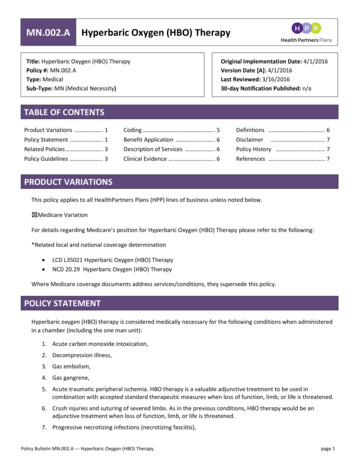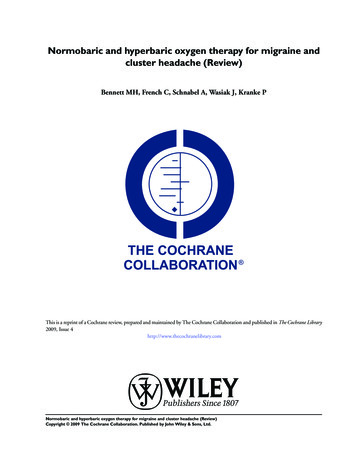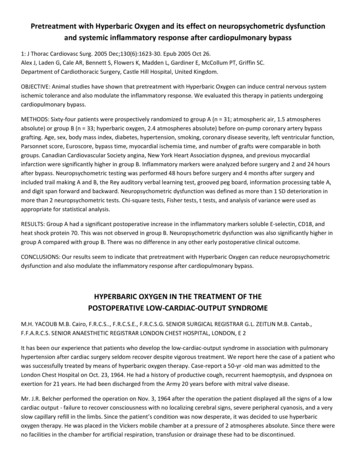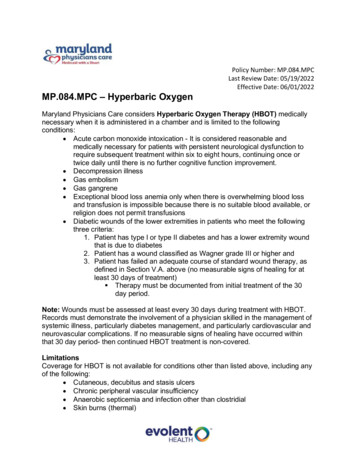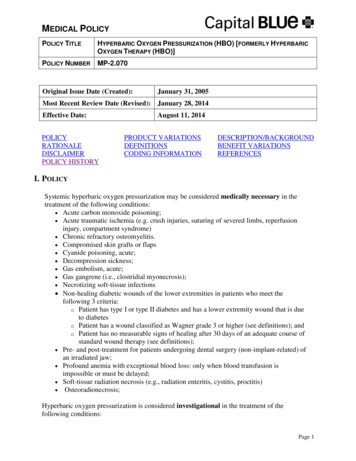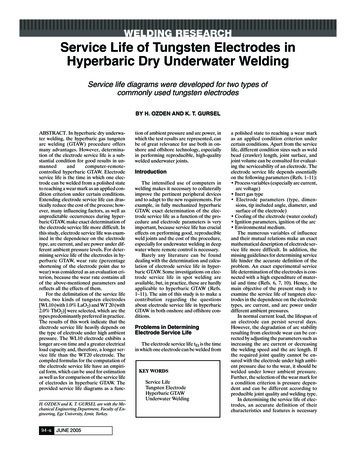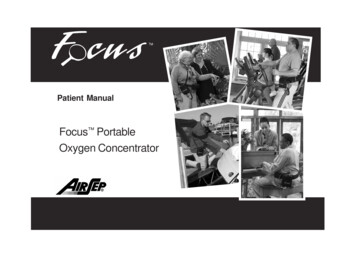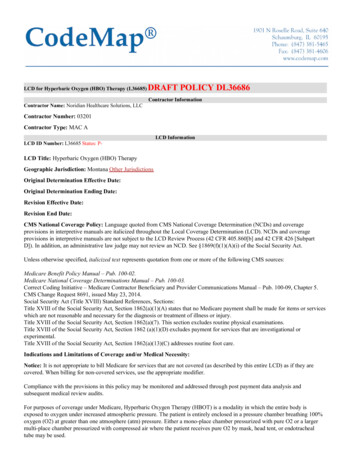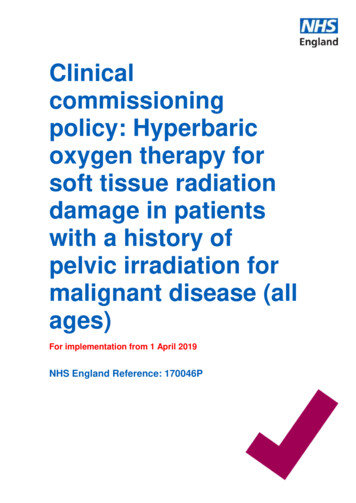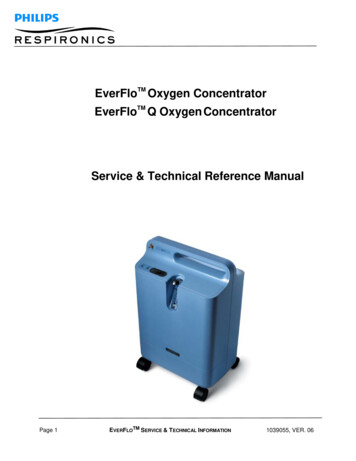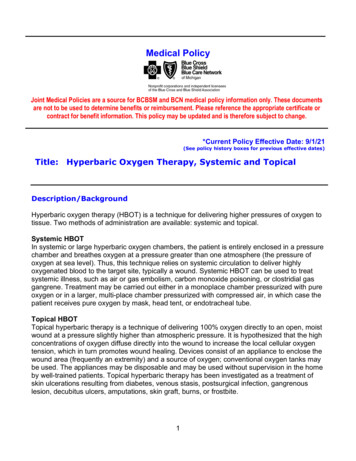
Transcription
Medical PolicyJoint Medical Policies are a source for BCBSM and BCN medical policy information only. These documentsare not to be used to determine benefits or reimbursement. Please reference the appropriate certificate orcontract for benefit information. This policy may be updated and is therefore subject to change.*Current Policy Effective Date: 9/1/21(See policy history boxes for previous effective dates)Title: Hyperbaric Oxygen Therapy, Systemic and TopicalDescription/BackgroundHyperbaric oxygen therapy (HBOT) is a technique for delivering higher pressures of oxygen totissue. Two methods of administration are available: systemic and topical.Systemic HBOTIn systemic or large hyperbaric oxygen chambers, the patient is entirely enclosed in a pressurechamber and breathes oxygen at a pressure greater than one atmosphere (the pressure ofoxygen at sea level). Thus, this technique relies on systemic circulation to deliver highlyoxygenated blood to the target site, typically a wound. Systemic HBOT can be used to treatsystemic illness, such as air or gas embolism, carbon monoxide poisoning, or clostridial gasgangrene. Treatment may be carried out either in a monoplace chamber pressurized with pureoxygen or in a larger, multi-place chamber pressurized with compressed air, in which case thepatient receives pure oxygen by mask, head tent, or endotracheal tube.Topical HBOTTopical hyperbaric therapy is a technique of delivering 100% oxygen directly to an open, moistwound at a pressure slightly higher than atmospheric pressure. It is hypothesized that the highconcentrations of oxygen diffuse directly into the wound to increase the local cellular oxygentension, which in turn promotes wound healing. Devices consist of an appliance to enclose thewound area (frequently an extremity) and a source of oxygen; conventional oxygen tanks maybe used. The appliances may be disposable and may be used without supervision in the homeby well-trained patients. Topical hyperbaric therapy has been investigated as a treatment ofskin ulcerations resulting from diabetes, venous stasis, postsurgical infection, gangrenouslesion, decubitus ulcers, amputations, skin graft, burns, or frostbite.1
Adverse EventsHBOT is a generally safe therapy, with an estimated adverse side effect rate of 0.4%.(1)Adverse events may occur either from pressure effects or the oxygen. The pressure effect(barotrauma) may affect any closed air-filled cavity such as ears, sinus, teeth, and lungs. Painand/or swelling may occur at these sites as pressure increases during the procedure anddecreases as the procedure is ending. Oxygen toxicity may affect the pulmonary, neurologic,or ophthalmologic systems. Pulmonary symptoms include a mild cough, substernal burning,and dyspnea. Neurologic effects include tunnel vision, tinnitus, nausea, and dizziness.Ophthalmologic effects include retinopathy in neonates, cataract formation, and transientmyopic vision changes.Note that this evidence review does not address topical oxygen therapy in the absence ofpressurization.Regulatory StatusSince 1979, the Food and Drug Administration (FDA) has cleared multiple topical and systemichyperbaric oxygen administration devices through the 510(k) pathway. In 2013, FDA publisheda statement warning that non-FDA approved uses of hyperbaric oxygen therapy (HBOT) mayendanger the health of patients.(2) If patients mistakenly believe that HBOT devices have beenproven safe for uses not cleared by FDA, they may delay or forgo proven medical therapies.Medical Policy StatementThe safety and effectiveness of systemic hyperbaric oxygen therapy have been established forsome conditions. It may be considered a useful therapeutic option when indicated for specifiedconditions.Topical hyperbaric oxygen therapy is experimental/investigational. It has not been scientificallydemonstrated to improve patient clinical outcomes.Inclusionary and Exclusionary Guidelines (Clinically based guidelines that maysupport individual consideration and pre-authorization decisions)Note: In some contracts, hyperbaric oxygen therapy may be excluded when performed in theoffice setting. Check with carrier for location restrictions.Inclusions:*For several of the indications included, there is little published evidence to support theeffectiveness of hyperbaric oxygen therapy. However, there is little likelihood of RCTs beingdone for such relatively rare indications. Generally, these patients present with clinically severesituations where therapeutic options are limited. Subject matter expert experience and limitedavailable evidence support that hyperbaric oxygen treatment may offer therapeutic benefit inthese cases.2
The following conditions are effectively treated by systemic hyperbaric oxygen therapy: Acute peripheral arterial insufficiency Acute traumatic peripheral ischemia: HBOT is a valuable adjunctive treatment to be usedin combination with accepted standard therapeutic measures when loss of function, limb,or life is threatened Carbon monoxide poisoning/intoxication, acute Chronic refractory osteomyelitis, unresponsive to conventional medical and surgicalmanagement Crush injuries and suturing of severed limbs as an adjunctive treatment when loss offunction, limb or life is threatened Cyanide poisoning, acute Decompression illness Diabetic wounds of the lower extremities in patients who meet ALL the following criteria:o A diagnosis of type 1 or type 2 diabetes with a lower extremity wound that is due todiabeteso A wound classified as Wagner grade III or higher The Wagner classification system of wounds is defined as follows: grade 0 no open lesion; grade 1 superficial ulcer without penetration to deeper layers; grade 2 ulcer penetrates to tendon, bone, or joint; grade 3 lesion has penetrated deeper than grade 2 and there is abscess,osteomyelitis, pyarthrosis, plantar space abscess, or infection of the tendonand tendon sheaths; grade 4 wet or dry gangrene in the toes or forefoot; grade 5 gangrene involves the whole foot or such a percentage that nolocal procedures are possible and amputation (at least at the below the kneelevel) is indicated.)o The patient has failed an adequate course of standard wound therapy. Standardwound care in patients with diabetic wounds includes ALL the following: The assessment of a patient’s vascular status and correction of any vascularproblems in the affected limb if possible The optimization of nutritional status Optimization of glucose control Debridement by any means to remove devitalized tissue Maintenance of a clean, moist bed of granulation tissue with appropriate moistdressings Appropriate off-loading Necessary treatment to resolve any infection that might be present. Gas embolism, acute Gas gangrene (i.e., clostridial myonecrosis) Non-diabetic wounds:o There is no measurable sign of healing for at least 30 consecutive days OR whenthere is failure to respond to standard wound care. Wounds must be evaluated at least every 30 days during administration of HBOTfor measurable signs of improvement. (see exclusion criteria) Osteoradionecrosis as an adjunct to conventional treatment Pre and post treatment for patients undergoing dental surgery (non-implant related) of anirradiated jaw3
Preparation and preservation of compromised skin grafts (not for primary management ofwounds)Profound anemia with exceptional blood loss: only when blood transfusion is impossible ormust be delayedProgressive necrotizing infectionsRefractory mycoses: mucormycosis, actinomycosis, Conidiobolus coronata only as anadjunct to conventional therapy when the disease process is refractory to antibiotics andsurgical treatment*Soft-tissue radiation necrosis (eg, radiation enteritis, cystitis, proctitis) as an adjunct toconventional treatmentWounds, including diabetic wounds, being treated with hyperbaric oxygen therapy must bereviewed using clinical documentation that identifies measurable signs of healing, e.g. width,depth and length of the wound.Exclusions: Topical hyperbaric oxygen therapy Hyperbaric oxygen pressurization is considered investigational in the treatment of thefollowing conditions, (this list may not be all-inclusive):o Acute coronary syndromes and as an adjunct to coronary interventions, including butnot limited to percutaneous coronary interventions and cardiopulmonary bypasso Acute or chronic cerebral vascular insufficiencyo Acute ischemic strokeo Acute osteomyelitis, refractory to standard medical managemento Acute thermal and chemical pulmonary damage, i.e. smoke inhalation with pulmonaryinsufficiencyo Acute surgical and traumatic woundso Arthritic diseaseso Autism spectrum disorderso Bell palsyo Bisphosphonate-related osteonecrosis of the jawo Bone graftso Brown recluse spider biteso Carbon tetrachloride poisoning, acuteo Cardiogenic shocko Cerebral edema; acuteo Cerebral palsyo Cerebrovascular disease, acute (thrombotic or embolic) or chronico Chronic arm lymphedema following radiotherapy for cancero Chronic peripheral vascular insufficiencyo Chronic wounds, other than those situations under the inclusionso Cosmetic useo Delayed onset muscle sorenesso Demyelinating diseases, e.g., multiple sclerosis, amyotrophic lateral sclerosiso Fibromyalgiao Fracture healingo Hepatic necrosiso Herpes zoster4
ooooooooooooooooooooooooooooooooooHydrogen sulfide poisoningIdiopathic femoral neck necrosisIdiopathic sudden sensorineural hearing lossInflammatory bowel disease (Crohn disease or ulcerative colitis)Intra-abdominal and intracranial abscessesIn vitro fertilizationLepromatous leprosyMeningitisMental illness (i.e., posttraumatic stress disorder, generalized anxiety disorder ordepression)MigraineMotor dysfunction associated with strokeMultiple sclerosisMyocardial infarctionNon-diabetic wounds Continued treatment should be discontinued when there are no measurable signsof healing within any 30-day period of treatment. (See Inclusions)Nonvascular causes of chronic brain syndrome (Pick’s disease, Alzheimer’s disease,Korsakoff’s disease)Organ storageOrgan transplantationPseudomembranous colitis (antimicrobial agent-induced colitis)Pulmonary emphysemaPyoderma gangrenosumRadiation-induced injury in the head and neck, except as noted under the inclusionsRetinal artery insufficiency, acuteRetinopathy, adjunct to scleral buckling procedures in patients with sickle cellperipheral retinopathy and retinal detachmentSenilitySepticemia, aerobicSepticemia (anaerobic) and infection other than clostridialSevere or refractory Crohn’s diseaseSickle cell crisis and/or hematuriaSkin burns (thermal), acuteSpinal cord injuryTetanusTraumatic brain injuryTumor sensitization for cancer treatments, including but not limited to, radiotherapy orchemotherapyVascular dementiaCPT/HCPCS Level II Codes (Note: The inclusion of a code in this list is not a guarantee ofcoverage. Please refer to the medical policy statement to determine the status of a given procedure.)Established codes:99183G02775
Other codes (investigational, not medically necessary, etc.):A4575E0446Note: Code(s) 99183 and G0277 may not be covered by all contracts or certificates. Please consultcustomer or provider inquiry resources at BCBSM or BCN to verify coverage.RationaleEvidence reviews assess the clinical evidence to determine whether the use of technologyimproves the net health outcome. Broadly defined, health outcomes are length of life, quality oflife, and ability to function - including benefits and harms. Every clinical condition has specificoutcomes that are important to patients and managing the course of that condition. Validatedoutcome measures are necessary to ascertain whether a condition improves or worsens; andwhether the magnitude of that change is clinically significant. The net health outcome is abalance of benefits and harms.To assess whether the evidence is sufficient to draw conclusions about the net health outcomeof technology, 2 domains are examined: the relevance, and quality and credibility. To berelevant, studies must represent one or more intended clinical use of the technology in theintended population and compare an effective and appropriate alternative at a comparableintensity. For some conditions, the alternative will be supportive care or surveillance. Thequality and credibility of the evidence depend on study design and conduct, minimizing biasand confounding that can generate incorrect findings. The randomized controlled trial (RCT) ispreferred to assess efficacy; however, in some circumstances, nonrandomized studies may beadequate. RCTs are rarely large enough or long enough to capture less common adverseevents and long-term effects. Other types of studies can be used for these purposes and toassess generalizability to broader clinical populations and settings of clinical practice.Evidence for a majority of the indications consists of Cochrane systematic reviews, whichfocus on summarizing RCTs, and when possible, conducting pooled analyses of results.Clinical Context and Therapy PurposeThe indications being reviewed in this policy are as follows: Topical hyperbaric oxygen therapy (HBOT) for:o Wounds, burns or infections - managed by neurologists and primary care providers inan outpatient clinical setting. Systemic HBOT for:o Acute coronary syndrome - managed by emergency physicians, cardiologists, andintensivists in an inpatient clinical settingo Acute ischemic stroke - managed by emergency physicians, cardiologists, andintensivists in an inpatient clinical settingo Acute surgical and traumatic wounds - managed by emergency care providers andsurgeons in an inpatient clinical settingo Acute thermal burns - managed by burn specialists and surgeons in an inpatientclinical settingo Autism spectrum disorder - managed by behavioral therapists and psychologists in anoutpatient clinical setting6
o Bell Palsy - managed by neurologists and primary care providers in an outpatientclinical settingo Bisphosphonate related osteonecrosis of the jaw - managed by surgeons, dentists,and oral maxillofacial surgeons in both inpatient and outpatient clinical settingso Carbon monoxide poisoning - managed in the emergency care setting by emergencymedicine physicianso Cerebral palsy - managed by physical therapists, physiatrists and primary careproviders in an outpatient clinical settingo Chronic diabetic ulcers - managed by surgeons, wound care specialists, podiatristsand primary care providers in a clinical settingo Chronic refractory osteomyelitis - managed by orthopedic surgeons, woundspecialists, and primary care providerso Delayed-onset muscle soreness - managed by physical therapists, physiatrists, andprimary care providers in an outpatient clinical settingo Fibromyalgia - managed by neurologists, physiatrists, physical therapists, and primarycare providers in an outpatient clinical settingo Herpes zoster - managed by infectious disease specialists and primary care providersin an outpatient clinical settingo Idiopathic femoral neck necrosis - managed by orthopedic surgeons in an inpatientclinical settingo Idiopathic sudden sensorineural hearing loss - managed by otolaryngologists andprimary care providers in an outpatient clinical settingo Individuals with cancer who are undergoing radiotherapy or chemotherapy - managedby oncologists in an outpatient clinical settingo Inflammatory bowel disease - managed by gastroenterologists and primary careproviders in a clinical settingo Migraine headache - managed by neurologists and primary care providers in anoutpatient clinical settingo Motor dysfunction associated with stroke - managed by physical therapists,physiatrists, and primary care providers in an outpatient clinical settingo Multiple sclerosis - managed by neurologists and primary care providers in anoutpatient clinical settingo Necrotizing soft tissue infections - managed by surgeons, wound care specialists, andinfectious disease specialists in an inpatient clinical settingo Radionecrosis, osteoradionecrosis and treatment of irradiated jaw - managed byradiation oncologists, orthopedic surgeons and oral maxillofacial surgeons potentiallyin both inpatient and outpatient clinical settingso Radiotherapy adverse events - managed by oncologists and primary care providers inan outpatient clinical settingo Traumatic brain injury – managed by emergency physicians, neurologists, physiatrists,physical therapists and primary care providers in an outpatient clinical settingo Vascular Dementia - managed by neurologists and primary care providers in anoutpatient clinical settingThe purpose of topical/systemic HBOT is to provide a treatment option that is an alternative oran improvement on existing therapies in patients with the indication being reviewed.7
The question addressed in this evidence review is: Does the use of topical/systemic hyperbaricoxygen improve net health outcomes when used as a treatment for the indication beingreviewed?The four components of a PICO question were used to select literature to inform thesereviews. Patientso The relevant population of interest are individuals with a diagnosis of the indicationbeing reviewed. Interventionso The therapy being considered is topical and/or systemic HBOT. Comparatorso Comparators of interest include standard of care and in some instances advancedtherapy. Topical/Systemic HBOT may be used as an adjunct to care. Outcomeso The general outcomes of interest include overall survival, symptoms, change indisease status and functional outcomes. The existing literature evaluatingtopical/systemic HBOT as a treatment for the indication being discussed reportedfollow-up at 12 weeks. However, longer follow-up is necessary to fully observeoutcomes. Therefore, at least one year of follow-up is considered necessary todemonstrate efficacy.Study Selection CriteriaMethodologically credible studies were selected using the following principles:a. To assess efficacy outcomes, comparative controlled prospective trials were sought,with a preference for RCTs;b. In the absence of such trials, comparative observational studies were sought, with apreference for prospective studies.c. To assess longer term outcomes and adverse events, single-arm studies that capturelonger periods of follow-up and/or larger populations were sought.d. Studies with duplicative or overlapping populations were excluded.TOPICAL HYPERBARIC OXYGEN FOR WOUNDS, BURNS, OR INFECTIONSde Smet et al (2017) conducted a systematic review of various oxygen therapies (oxygendressing therapy, topical oxygen therapy, HBOT, inspired oxygen therapy).(3) Three RCTsevaluating topical oxygen therapy for chronic wound healing were identified (see Table 1). OneRCT (N 100) administered treatment for 20 minutes 3 times per day for 12 days to thetreatment group and standard care to the control group. The number of patients experiencingcomplete wound healing, defined as complete epithelialization of the wound without drainage,was 16 in the experimental group and 1 in the control group (p 0.001). Two of the RCTs,which had overlapping populations with refractory venous ulcers (n 83 in one and n 132 in theother) administered treatment for 180 minutes 2 times per day for 12 weeks to the treatmentgroup and conventional compression dressing to the control group. In all trials, patients in thetreatment group experienced significantly higher proportions of healed ulcers and significantlyfaster healing times.8
A small RCT reported by Leslie (1988) not included in the systematic review evaluated 28patients with diabetic foot ulcers who were assigned to topical HBOT plus standard woundcare or standard wound care alone.(4) Changes in ulcer size and depth did not differ betweenthe two groups following two weeks of treatment.Table 1. Systematic Reviews of Trials Assessing Topical Hyperbaric Oxygen for WoundsStudyLiterature(Year)SearchStudies ParticipantsN (Range) Design Resultsde Smet et Feb 20163Stage II-IV sacral or315a (83RCT Results not pooled3al (2017)ischial pressure ulcers132) In all trials, patients(1 RCT)in the treatmentRefractory venousgroup experiencedulcers (2 RCTs)significantly higherwound healing ratesRCT: randomized controlled trial.a Two of the trials had overlapping populations, so there were not 315 unique patients.Section Summary: Topical Hyperbaric Oxygen for Wounds, Burns, or InfectionsA systematic review identified three RCTs on the use of topical HBOT for chronic woundhealing. The results showed topical oxygen therapy improved wound healing, but there washeterogeneity in the trial populations and treatment regimens. There is a small RCT on topicalHBOT for diabetic foot ulcers; it showed no differences in outcomes between the treatmentand control group. No controlled studies on topical HBOT for patients with burns or infectionswere identified. The data are insufficient to draw conclusions about the effect on the net healthoutcome.SYSTEMIC HYPERBARIC OXYGEN THERAPY FOR CHRONIC DIABETIC ULCERSSystematic ReviewsA Cochrane review of RCTs on HBOT for chronic wounds was published by Kranke et al in2015 (see Table 2).(8) Reviewers identified 12 RCTs (total N 577 participants) comparing theeffect of HBOT on chronic wound healing with an alternative treatment approach that did notuse HBOT. Ten of the 12 trials evaluated HBOT in patients with diabetes (N 531). The trialswere assessed as moderate quality using the GRADE system. HBOT regimens varied acrossstudies, ranging from 3.0 atmospheres absolute (ATA) for 45 minutes to 2.2 ATA for 120minutes. In a pooled analysis of 5 trials, a significantly higher proportion of ulcers had healedat the end of treatment (ie, 6 weeks) in the group receiving HBOT than in the group notreceiving HBOT, but there was no statistically significant difference in the risk of majoramputations between groups.A systematic review by Elraiyah et al (2016) evaluated adjunctive therapies (HBOT, arterialpumps, and pharmacologic agents) used to treat diabetic foot ulcers (see Table 2).(9) RCTsand nonrandomized cohort studies were included. The RCTs were rated as low-to-moderatequality using the GRADE system. A pooled analysis of six RCTs found a significantly higherhealing rate and a significantly lower major amputation rate (odds ratio, 0.30; 95% confidenceinterval, 0.10 to 0.89) with HBOT than with control.Table 2. Systematic Reviews of Trials Assessing HBOT for Chronic Diabetic Foot UlcersStudyLiterature(Year)SearchStudies ParticipantsNDesign Results9
Kranke etal (2015)8,Feb 201512Patients withchronic woundsassociated withvenous or arterialdisease, diabetes,or externalpressure577RCTsElraiyah etal (2016)9,Oct 201118Patients withdiabetic footulcers1526RCTs,cohort 10 of 12 trials focused onpatients with diabetic footulcers (n 531) Pooled analysis of 5 of 10trials (n 205) reported higherheal rates with HBOT (RR 2.3;95% CI, 1.2 to 4.6) and nodifference in amputation risk(RR 0.4; 95% CI, 0.1 to 2.2) 16 of 18 trials included HBOTas a treatment option and 6 ofthose were RCTs Pooled analysis of the 6 RCTs(n 340) reported higher healrate with HBOT (OR 14.3;95% CI, 7.1 to 28.7) and loweramputation risk (OR 0.3; 95%CI, 0.1 to 0.9)CI: confidence interval; HBOT: hyperbaric oxygen therapy; OR: odds ratio; RCT: randomized controlled trial; RR: relative risk.Section Summary: Chronic Diabetic UlcersMultiple RCTs and two systematic reviews have been published. Seven RCTs were commonin the two systematic reviews. Pooled analyses of RCTs found significantly higher woundhealing rates with HBOT than with control conditions. One of the two meta-analyses, but notthe other, found that HBOT was associated with a significantly lower rate of major amputation.SYSTEMIC HYPERBARIC OXYGEN THERAPY FOR CARBON MONOXIDE POISONINGA Cochrane review by Buckley et al (2011) included six RCTs evaluating HBOT for carbonmonoxide poisoning (see Table 3).(10) Four of the six trials were assessed as having a highrisk of bias due to nonblinding of treatment allocation. The trials had substantial methodologicand statistical heterogeneity. The outcome of interest was dichotomous, presence or absenceof signs or symptoms indicative of neurologic injury at four to six weeks after study inclusion.Two of the six RCTs found that HBOT reduced the likelihood of neurologic sequelae at onemonth and four others did not find a significant effect. A pooled analysis of the six trials did notfind a significant effect of HBOT on neurologic injury. Reviewers concluded that there wasinsufficient evidence to determine whether HBOT reduces the risk of adverse neurologicoutcomes after carbon monoxide poisoning. Quality of the evidence was deemed very low,using the GRADE system.Table 3. Systematic Reviews of Trials Assessing HBOT for Carbon Monoxide PoisoningStudyLiterature(Year)SearchStudies ParticipantsNDesign ResultsBuckleyJun 20106Nonpregnant1361RCTs Studies extremely heterogeneouset aladults within: severity of CO poisoning, HBOT(2011)10,acute carbonregimens, and comparatorsmonoxide Pooled analyses of 6 trials (N 1361)poisoningreported no statistical difference inneurologic deficits between treatmentgroups (OR 0.78; 95% CI, 0.54 to1.12)CI: confidence interval; CO: carbon monoxide; HBOT: hyperbaric oxygen therapy; OR: odds ratio; RCT: randomized controlledtrial.10
Nonrandomized Comparative StudiesNakajima et al (2020) conducted a retrospective cohort study comparing the effect of HBOTversus control (no HBOT) on mortality and morbidity in patients with carbon monoxidepoisoning.(85) The median number of HBOT sessions was 3(range 2 to 5). After propensityscore matching of study participants (N 4,068) the study found no significant differencebetween groups in in-hospital mortality (mean rate difference -0.4%, 95% confidence interval 1.0 to 0.2%). Results were consistent across subgroups according to severity of carbonmonoxide poisoning, age and number of HBOT sessions. However, the study found HBOTassociated with lower rates of depressed mental status (mean difference -3.2%, 5%confidenceinterval -4.9% to -1.5%) and reduced activities of daily living (mean difference -5.3%, 95%confidence interval-7.8% to -2.7%) relative to no HBOT.Section Summary: Systemic HBO for Carbon Monoxide PoisoningA Cochrane review identified six RCTs, the majority of which did not find a significant effect ofHBOT on health outcomes. In addition, a pooled analysis of RCT data did not find a significanteffect of HBOT on neurologic injuries and the quality of the evidence was considered very low.SYSTEMIC HYPERBARIC OXYGEN THERAPY FOR RADIONECROSIS,OSTEORADIONECROSIS, AND TREATMENT OF IRRADIATED JAWBennett et al (2016) published a Cochrane review on HBOT for late radiation tissue injury (seeTable 4).(11) Reviewers identified 14 RCTs. In a pooled analysis of three studies, asignificantly higher proportion of patients with osteoradionecrosis achieved complete mucosalcover after HBOT than with control treatments (RR 1.30; 95% CI, 1.09 to 1.55). In addition, apooled analysis of two trials found a significantly lower risk of wound dehiscence after surgeryto repair mandibular osteoradionecrosis with HBOT than with control treatments (RR 4.23;95% CI, 1.06 to 16.83). A single trial found a significantly higher likelihood of successfulhealing with HBOT than with antibiotics for tooth extraction in irradiated jaws (absolute riskreduction, 25%; p 0.02). There were insufficient data to conduct meta-analyses on otheroutcomes.Borab et al (2017) published a systematic review focusing on the use of HBOT to treat thesubgroup of patients with late radiation tissue injury had skin necrosis (see Table 4).(12)Reviewers identified eight studies, including a large observational cohort and several caseseries. No RCTs were identified. The risk of bias was high due to the design of the includedstudies. The studies reported improved healing, though, without a comparator, interpretation ofthe results is limited.Ravi et al (2017) published a systematic review on the use of HBOT to treat patients who hadreceived radiotherapy for head and neck cancer.(13) Ten prospective case series andcomparative studies were identified. Qualitative summaries of outcomes were provided, butpooled analyses were not performed. Outcomes of interest included osteonecrosis and dentalimplant survival (see Table 4). Other outcomes of interest included salivary gland function andquality of life, which are discussed in the Radiotherapy Adverse Events section.Table 4. Systematic Reviews of Studies Assessing HBOT for Radionecrosis, Osteoradionecrosis, andTreatment of Irradiated JawStudyLiterature(Year)SearchStudies ParticipantsNDesignResults11
Bennett etal (2016)11,Dec 201514Patients withlate radiationtissue injury(includingnecrosis) andpatientstreated withlarge-doseradiotherapylikely toinduce earlynecrosis753RCTsBorab etal (2017)12,May 20168Patients withradiationinduced skinnecrosis720Observationalcohort andcase seriesRavi etal (2017)13,Dec 201610Patients whoreceivedradiotherapyfor head andneck cancer375Prospectivecase seriesandprospectivecomparativestudies Pooled analyses of 3 trials ofpatients withosteoradionecrosis (n 246)found a higher rate of completemucosal cover after HBOT vscontrol (RR 1.3; 95% CI, 1.1to 1.5) Pooled analyses of 2 trials(n 264) found a lower risk ofwound dehiscence followingsurgery to repair mandibularosteoradionecrosis in patientstreated with HBOT vs control(RR 4.2; 95% CI, 1.1 to 16.8) Adding across the studies,80% reported complete healingand 86% reported symptomimprovement Studies had no comparators Osteonecrosis prevention: 1case series and 1 comparativestudy (n 77) reported lowosteonecrosis rates with HBOT Dental implant survival: 1 caseseries and 2 comparativestudies (n 122) report mixedresults, with 2 studies findingimplant survival improved withHBOT and another finding nodifference in survivalCI: confidence interval; HBOT: hyperbaric oxygen therapy; RCT: randomized controlled trial; RR: relativ
Hyperbaric oxygen therapy (HBOT) is a technique for delivering higher pressures of oxygen to tissue. Two methods of administration are available: systemic and topical. Systemic HBOT . In systemic or large hyperbaric oxygen chambers, the patient is entirely enclosed in a pressure
